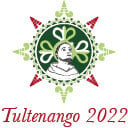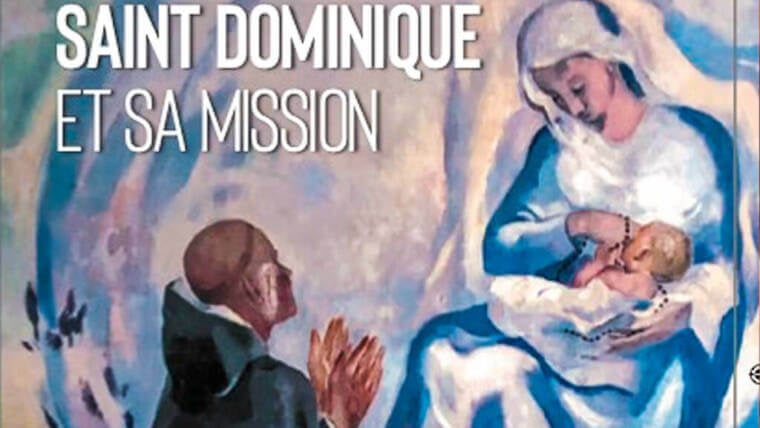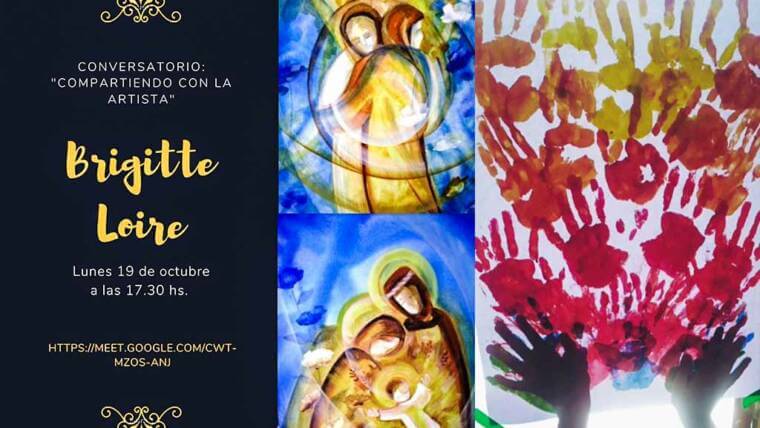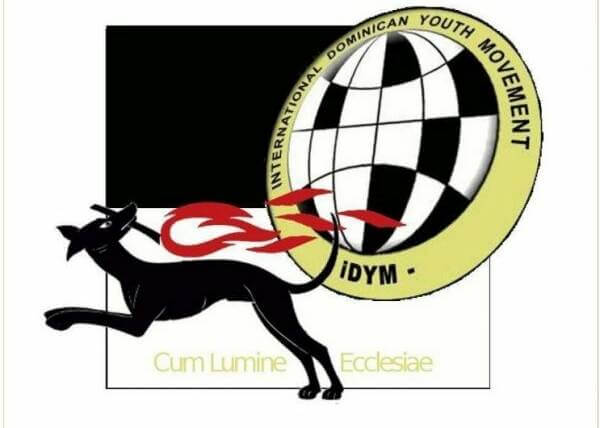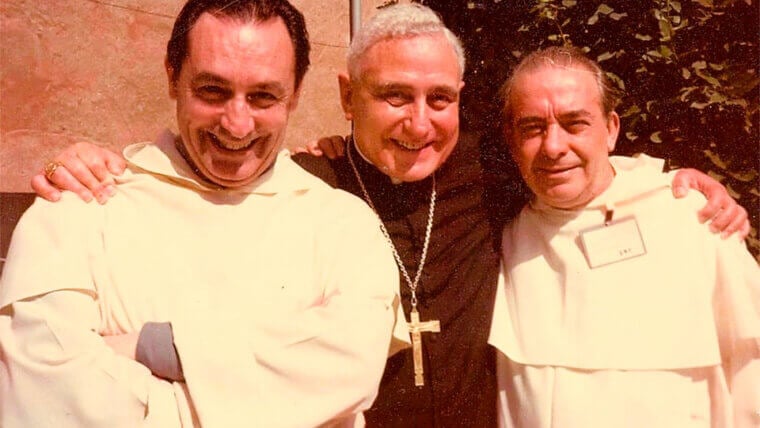Anecdotes of Brother Carlos Azpiroz, OP
(Part II)

My first meeting with him was the morning of 9 January 1980 in Rome. Jorge Scampini and I with other colleagues from the Faculty of Law (UCA) were heading that morning for the Paul VI Hall to attend the general audience with John Paul II. We were excited as we waited near the gate of Piazza Pio XII, 3, in which the then Sacred Congregation for Religious and Secular Institutes still operates on the first floor. Our excitement grew stronger as we realised that at that hour Cardinal Pironio must surely be arriving for work from the Palace of the Holy Office, across St. Peter’s Square, where he resided until his death. When we saw him walking in, wearing his beret and a simple overcoat, we greeted him enthusiastically. We told him that we were Argentinians and that in a few days, on 20 February, we would be entering the novitiate of the Order in Mar del Plata. He gave us a big, emotional, heartfelt hug and his blessing. What a great joy that was!
Years later, Providence gave us an enormous gift, a real grace. When the time came for our ordination as deacons he presided at the Eucharist and conferred Holy Orders on us with the imposition of his hands. It was 8 August 1986, the Feast of St. Dominic. His homily, delivered in the Basilica of Our Lady of the Rosary in Buenos Aires, is still remembered by many friars as a true hymn to the mission of the preacher who follows in the footsteps of St. Dominic, Our Father. At that Eucharist, Brother Jorge Scampini, OP, Brother José María Cabrera, OP, Brother Alberto Saguier, OP, and myself were ordained. A year later, also in the Convent of St. Dominic in Buenos Aires, another great joy: on the vigil of the “Easter of Our Lady”, as he himself used to call the solemnity of the Assumption of the Virgin Mary, he ordained the four of us priests. From then on, we often exchanged letters.
On 25 May 1992 Brother Damian Byrne, OP, then Master of the Order, left Santa Sabina for his last trip to Latin America, as the elective General Chapter was due to begin in Mexico on 1 July. Three days earlier, he had asked me to accompany him to the Palace of St. Callixtus in Trastevere, where the Pontifical Council for the Laity has its headquarters. He wanted to bid farewell to Cardinal Pironio, who was then President of that Dicastery of the Roman Curia. I was a privileged witness to this simple and eloquent meeting of two friends of God, without protocol. Their love for St Dominic and the Dominican family also united the two. On the way back to Santa Sabina, Br Damian confided to me that Eduardo Pironio had helped him a lot in his early days as Master, when the Cardinal was still Prefect of the Congregation for Religious. Moreover – and I quote him – Br Damian concluded: “I have never heard such beautiful words about St. Dominic as those he addressed to the capitular friars in Rome in 1983.”
When I returned to Rome in June 1997, summoned by Brother Timothy Radcliffe, OP, to be Procurator General of the Order, I began to visit the Cardinal regularly. His presence and his words nourished my spirit. I remember with special affection and emotion those frequent visits that continued until the Lord called him to live the fullness of his friendship, at his side, forever.
Eduardo Pironio asked to be buried in Argentina, in the Basilica-Shrine of Our Lady of Luján, where he had been ordained priest on 5 December 1943, where he received his episcopal consecration on 31 May 1964 and where he joyfully celebrated his Golden Jubilee of priesthood. His tomb, like that of Paul VI in St. Peter’s, inspires deep and heartfelt devotion and continues to be a necessary stop on the pilgrimage to the Father’s house.
The Cardinal has left an indelible mark on religious and consecrated life, himself a true witness of Easter joy. His time in the diocesan seminaries of Mercedes and Villa Devoto in Buenos Aires (in Argentina); his work with Catholic Action; his pastoral work in the Faculty of Theology of the Pontifical Catholic University of Argentina, where he was professor and dean; his presence at the Second Vatican Council (participating as an expert); his ministry as a shepherd as diocesan Bishop; the capable service to the Latin American Church as secretary and president of CELAM; his responsibility as Prefect of the Congregation for Religious Life; the presidency of the Pontifical Council for the Laity; the promotion of the memorable World Youth Days—a true worldwide event of the “Invasion of the Peoples” in his beloved diocese of Mar del Plata; the annual convocation of all the young people of the diocese who literally “invaded” various localities ready to welcome them for a weekend of reflection, prayer and celebration. All of this was moulding in him a truly ecclesial, universal, joyful and youthful heart, even in the midst of the suffering that he always bore in profound silence. What an Easter mystery!
I would like to describe in simple terms the “Dominican profile” of this brother of ours — a member of the family of St. Dominic — without claiming to appropriate the universality of his heart. He possessed a remarkable confidence in the work of the Holy Spirit that enabled him to take part in the quaestiones disputatae of his time. While a faithful heir of tradition, he never wished to remain intellectually frozen. Eduardo Pironio was, in fact, heir to a living tradition that has made its contribution in every age. This tradition, which he has embodied with docility, is based on fundamental philosophical and theological intuitions: an understanding of morality in terms of the virtues and the growth of the virtues; the ontological goodness of all creation; confidence in reason and in the role of debate; profound joy in the vision of God as our destiny; and a humility before the mystery of God that always took him beyond ideologies. This tradition that was cultivated in the soul of Eduardo Pironio has immense importance today in a world that is often tempted by intellectual pessimism, lack of confidence that truth can be attained, or by brutal fundamentalism. It is founded on the confidence that we have a propensio ad veritatem. His special “wisdom of the heart”, from which has enriched so many of us, is a heritage of immense importance for and in the Church, which is often divided by ideological differences with theologians or thinkers shooting at each other from opposite trenches out of fear of a true intellectual encounter with those who think differently.
His spiritual testament, paraphrased by Pope John Paul II at the funeral in St. Peter’s Basilica on Saturday 7 February, attended by several Dominican friars and sisters, is a song of thanksgiving, a true Magnificat.
I conclude stammering in admiration, I bow my head and raise my spirit in front of this living memory: His life was a hymn to Christian joy and to the joy of consecrated life; to evangelical friendship as an expression of God’s love; to the Paschal Cross lived in the depths of the priestly ministry; all this is part of a precious heritage, embellished by a singular filial love for Mary, the faithful Virgin. This is the testament he left to those of us who had the grace to know in him the love of a friend.
Among his many writings I would like to quote, by way of conclusion, the final paragraphs of his “Reflections on Friendship”, the fruit of reading chapters VIII and IX of Aristotle’s Ethics, the respective commentaries of St Thomas – our brother – and some texts of the Summa Theologiae (I-II q.4 a.8 and II-II q.23-33).
“For the imperfect happiness of the earth – made with tears and effort – the joyful presence of the friend who soothes and sustains us, raises us up and perfects us is indispensable to us. His discovery constitutes, among the miseries of time, the most invaluable wealth. Among the accidental joys of glory, St Thomas places the reunion with the friend.
Perfect happiness consists in the intuitive vision of God. There man will find the fullness of his perfection. Essentially nothing else is needed for beatitude. But the completion of happiness still demands the irreplaceable presence of the friend. Death can temporarily break a friendship. But in the open furrow of the wound, the definitive encounter has been sown. The supreme perfection of a friendship is then reached in eternity. There, the greatest similarity and the most indestructible coexistence will be achieved.”
Finally, an expression of affection made prayer… Dear brother, Eduardo, preacher of joy, of the Easter cross accepted with love, thank you for your friendship! Rest in Peace, and pray for us. Amidst the miseries of time we continue to walk joyfully in hope until the final encounter, begging for the Father’s mercy!

Brother Carlos A. Azpiroz Costa, OP

